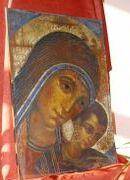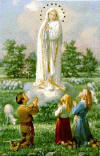Mary (Mother Of Jesus)
 From Conservapedia
From Conservapedia Mary (Blessed Virgin Mary or Our Lady, Greek: Μαρία, Spanish: Virgen María, French: Notre-Dame, Italian: Madonna) is the name of the mother of our Lord, Jesus of Nazareth. In the Gospel accounts, Jesus was born in Bethlehem of Judea to a young virgin, by the Holy Spirit. The gospel of Matthew describes the virgin birth of Jesus as fulfilling the prophecy of Isaiah 7:14. The gospel of Luke relates that the angel Gabriel visited Mary in order to announce to her that she had been chosen to bear the Son of God.[1]
There is an interesting contrast in the portrayal of Mary by the Gospel of Luke and the Gospel of John,[2] which were independently written having very little overlap.
Contents
- 1 Crucifixion
- 2 Catholic and Orthodox Views of Mary
- 3 Protestant View of Mary
- 4 Marian Prayers
- 4.1 Hail Mary
- 5 Virginity of Mary
- 6 Major Apparitions
- 7 Outside Christianity
- 8 See also
- 9 External links
- 10 References
Crucifixion[edit]

Mary was present during the crucifixion of Jesus Christ along with other women who had followed Jesus from Galilee.
While Jesus was hanging on the cross, "there stood by the cross of Jesus, his mother, and his mother's sister, Mary Cleophas, and Mary Magdalene. When Jesus therefore had seen his mother and the disciple standing whom he loved, he saith to his mother: Woman, behold thy son. After that, he saith to the disciple: Behold thy mother. And from that hour, the disciple took her to his own" (John 19:25-27).
Following the crucifixion:
| “ | Jesus was in the grave for three days. After the Sabbath, Mary Magdalene, Mary (the mother of Jesus), and Salome prepared spices to anoint Jesus' body. When they arrived at the tomb, the stone had already been rolled away! They entered the tomb, where an angel said, "Don't be alarmed. . .You are looking for Jesus the Nazarene, who was crucified. He has risen! He is not here. See the place where they laid him. But go, tell his disciples and Peter, 'He is going ahead of you into Galilee. There you will see him, just as he told you'" (Mark 16:6-7). [3] | ” |
Catholic and Orthodox Views of Mary[edit]
The veneration of Mary is an essential belief of the Catholic Church. Mary is also venerated by Eastern Orthodox Church and Anglo-Catholicism. This veneration could take the form of prayer for intercession with her Son, Jesus. Many Protestants, however, believe that the veneration of Mary is counter to what the Bible teaches. [4] [5] [6] [7] [8] For years, when it comes to Mary, Catholics and Protestants have been quite contrary. However, there are growing signs that differences over Mary are becoming less apparent. Many Protestant leaders are reevaluating and saying a greater emphasis on Mary needs to be considered. [9]
Mary's passage into Heaven is celebrated by Roman Catholics as The Feast of the Assumption of the Blessed Virgin Mary (March 25 and August 15). This Feast is a Public Holiday in many countries. In 1950, Pope Pius XII formally declared to be dogma the belief in the corporeal assumption of Mary, which is known as the Assumption of Mary.
| “ | Scripture and tradition agree in ascribing to Mary the greatest personal sanctity; She is conceived without the stain of original sin; She shows the greatest humility and patience in her daily life (Luke 1:38, 48); She exhibits an heroic patience under the most trying circumstances (Luke 2:7, 35, 48; John 19:25-27)... within the first fifty years after the death of St. John the veneration of Mary is proved to have flourished in the Church of Rome. [10] | ” |
The Orthodox Church expresses reverence toward the Blessed Virgin by the many feast days commemorating the various events in her life. In prayers the Virgin Mary is called Theotokos, which in Greek means the Mother of God, since the One Who was born from her was at the time of conception and always will be the true God.[11]
“Henceforth all generations will call me blessed.” Mary, Luke 1:48.
Protestant View of Mary[edit]
While Protestants respect the life of Mary, some Protestants believe that the veneration of Mary is counter to what the Bible teaches. [12] [13] [14] [15] For some Anglican Christians Mary has an special position within God's purpose of salvation. (Catholics, Orthodox, and Anglicans, make a clear distinction between veneration (which is also due to the other saints) and adoration which is due to God alone).
The Website ReligionFacts states:
| “ | ....most Protestants have shown a great deal of honor and respect for Mary. Martin Luther said Mary is "the highest woman," that "we can never honour her enough," that "the veneration of Mary is inscribed in the very depths of the human heart" and that we should "wish that everyone know and respect her." John Calvin said, "It cannot be denied that God in choosing and destining Mary to be the Mother of his Son, granted her the highest honor." Zwingli said, "I esteem immensely the Mother of God," and, "The more the honor and love of Christ increases among men, so much the esteem and honor given to Mary should grow." [16] | ” |
Marian Prayers[edit]

Classical Prayers
Hail Mary[edit]
The prayer "Hail Mary" (Ave Maria) has its roots in Luke 1:42 where Elizabeth (who is Mary's cousin) salutes Mary and in Luke 1:28 where the Arch Angel Gabriel salutes Mary.
Hail Mary, full of grace, the Lord is with thee, blessed art thou among women[17] and blessed is the fruit of thy womb[18] Jesus. Holy Mary, Mother of God, pray for us sinners now, and at the hour of our death. Amen.
- Salve Regina (Hail, Holy Queen)
- Litany of the Blessed Virgin Mary
- Mary, Mother of Grace
- Prayer of the memorial of Our Lady of Guadalupe
- Mary, Help of Those in Need
- Sub Tuum Praesidum
The Rosary combines vocal prayer and meditation centered around sequences of reciting the Lord's Prayer followed by ten recitations of the "Hail Mary" prayer and a single recitation of "Glory Be to the Father".
Virginity of Mary[edit]
While the Catholic and Orthodox churches believe that Mary remained a virgin after the birth of Jesus, most Protestants do not.
Protestants base their views on the use of the word "until" and (in some translations) "firstborn" in Matthew 1:25[19], as well as references to brothers and sisters of Jesus, with James the Just among those listed, in Matthew 13:55, Mark 6:3, and Galatians 1:19.[20] [21] [22].
The 1913 Catholic Encyclopedia notes that historical use of words like "brethren" and "brothers and sisters" could also apply to stepbrothers, cousins, and other relatives.[23] Also, historical uses of "until" do not necessarily imply an end, for example, "until the end of time" in Matthew 28:20, when time has no end in Christianity.[24] [25]
Major Apparitions[edit]

- Guadalupe, 1531
- Lourdes, 1858
- Fatima, 1917
In the US, Lady of Prompt Succor, (New Orleans, United States, 1809). Wind-blown fire changes directions, sparing the convent; President of the United States Andrew Jackson credits the Lady with the victory in the famous Battle of New Orleans in 1815.
Outside Christianity[edit]
Several hundred years after Mary lived, Muhammad mentioned her (Marian) and his words were recorded by his followers in the Koran. It should also be noted that Fatima, a Portuguese town where a major apparition took place, was named after one of Muhammad's daughters[26]
See also[edit]
- Our Lady of Guadalupe
- Ave Maria
- Annunciation
- Mary Magdalene
- Rosary
- Virgin Mary gallery
- St. Joseph
- Jesus Christ
External links[edit]

- The Blessed Virgin Mary Catholic Encyclopedia.
- Blessed Virgin Mary
- The Rosary
- Hail Mary Information on the Blessed Virgin Mary.
- The Mystery of the Virgin of Guadalupe
- Virgin Mary, Other Apparitions
- Apparitions of the Virgin Mary, A Protestant Look at a Catholic Phenominon: Part Two
- Feast of the Holy Name of Mary
- The Mary Page About Mary.
References[edit]

- ↑ Luke 1:26–38
- ↑ https://udayton.edu/imri/mary/g/gospels-of-luke-and-john-differences.php
- ↑ Crucifixion of Jesus Christ - His Burial and Resurrection
- ↑ The Saints and the Virgin Mary
- ↑ Problems with the Mary of Roman Catholicism
- ↑ The Biblical, Catholic, and Occult View of Mary
- ↑ Cult of Mary - Part One
- ↑ Cult of Mary - Part Two
- ↑ Understand The Times MARYIANITY by Roger Oakland
- ↑ Catholic Encyclopedia.
- ↑ Honoring the Blessed Virgin Mary
- ↑ Problems with the Mary of Roman Catholicism
- ↑ The Biblical, Catholic, and Occult View of Mary
- ↑ Cult of Mary - Part One
- ↑ Cult of Mary - Part Two
- ↑ Mary in the Reformation and Protestantism
- ↑ Luke 1:28,42
- ↑ Luke 1:42
- ↑ Matthew 1:25
- ↑ Matthew 13:55
- ↑ Mark 6:3
- ↑ Galatians 1:19
- ↑ http://www.newadvent.org/cathen/02767a.htm
- ↑ http://www.newadvent.org/bible/mat001.htm#vrs16
- ↑ Matthew 28:20
- ↑ http://www.pbs.org/muhammad/ma_women.shtml
Categories: [Catholic Church] [Biblical Women] [Saints] [Early Christians] [Christianity] [Featured articles]
↧ Download as ZWI file | Last modified: 02/26/2023 08:47:11 | 204 views
☰ Source: https://www.conservapedia.com/Mary_(mother_of_Jesus) | License: CC BY-SA 3.0
 ZWI signed:
ZWI signed: KSF
KSF